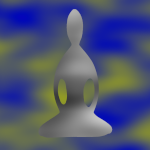Dear Friends,
After we initially establish mindfulness and start to recognize what is happening, we can open up to observing what is happening, without interference.
Observation is the third aspect of sati that Gil discusses.
https://www.audiodharma.org/talks/11122
When we observe what is happening, we are not interfering with judgments, stories, attitudes, etc., that can cloud our perception. Gil notes, “It’s not easy to watch without interference.” I’m sure you’ll agree!! He says it’s helpful to be watching “360 degrees … everything can be included – including our interference.” That too can be just one more thing to observe.
He describes this as a radical act – to be simple – as it “begins to loosen, dissolve, and unravel all of these complex worlds we have of the reactivity, judgments, ideas, and stories through which we see ourselves and our world.”
Gil shares one of his favorite analogies to describe when we are observing and when we are not. It’s as if we’re leaning against a tree, watching a river flow by, and then a boat comes along. Often, we jump on the boat and don’t even notice until some time has passed! But eventually we realize there are other options – and we don’t have to jump on those thought-boats; we can let them pass.
Practice:
Gil closes his talk with a practice suggestion:
“In the time between now and tomorrow, you might be curious about this human capacity to observe experience. You might even go and sit somewhere quiet, and use your eyes to just watch the world go by. Watch nature. Watch the squirrels playing in the trees. Watch the clouds go by. See what you can learn about what it is like just to observe. Just observe — not interfere, not react, not make stories. Just let things gently flow by. Stand in the middle of your river, and just let all things flow by until such a time when everything is just observed, and there is no observer. Even the observer is flowing by.”
Poem:
I found this poem from James Crews, which brings in a bit of the noting practice discussed yesterday, where he starts the poem noting “thinking,” but then even gets caught in his observation of nature by layering on some “shoulds.” His commentary after the poem reminds us to “bring a lighthearted, friendly approach to the whole thing, without feeling like a failure. The mind is meant to serve the heart, after all, and not the other way around.”
You can read “Thinking about Thinking” and his reflections here:
https://singingbowl.org/thinking-about-thinking/
Meditation:
Like James, one of the sticky things I find hard to observe in meditation is thoughts. We can bring a light touch to observing them. Here’s brief talk (10 minutes) followed by a meditation (24 minutes) by Devon Hase:
https://www.dharmaseed.org/talks/72622/
With good wishes,
Andrea

Today’s Daily Tejaniya speaks to working with thoughts:
Thoughts are nature. They are a process of mind. We should recognize thoughts, acknowledge them. Thoughts are not a problem. It’s important not to struggle with your thoughts.
http://eepurl.com/iikkkv